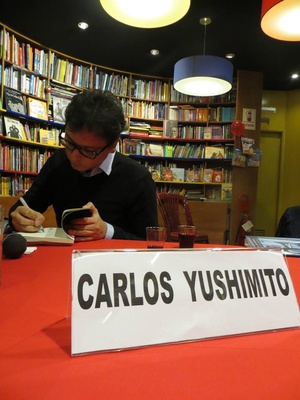The work of the Peruvian writer Carlos Yushimito Valle (Lima, 1977) is as peculiar as it is captivating and thoughtful, full of strange characters, fantastic stories and situations in which a narrative style comes to light that has elevated him since his early years, when his Stories began to appear in university magazines, anthologies of young storytellers and artisanal or digital publications.
Since then, it has captivated editors from Peru, Argentina, Colombia, Bolivia, Ecuador, Spain and the United States; including those of the prestigious magazine Granta , which in 2010 chose him among the 22 promising writers under 35 years old, along with the Chilean Alejandro Zambra, the Peruvian Santiago Roncagliolo and the Argentineans Andrés Neuman, Pola Oloixarac and Samanta Schweblin.
Translated into English, Italian and French, republished and illustrated, his literary career runs alongside the academic one he continues at Brown University, in Providence, Rhode Island, where he is pursuing a doctorate in the Department of Hispanic Studies that has taken him to write essays and give lectures around the topic of reading or on your own poetic art.
“He is one of the new Peruvian authors who take risks in their writing and at the same time draw heavily on literary tradition,” says Ricardo Sumalavia, responsible for the anthology of short stories (“Selección peruana 2000-2015”, published this year by Estruendomudo). . “I liked its dialogue with other texts, without falling into cryptic readings, but on the contrary, creating a larger spectrum, much richer and more suggestive,” adds the writer, who is also a writer.
Poetics of the story
Since his first stories, which circulate on the Internet and were published in three books (" The Magician ", in 2004, "The Islands", in 2006, and "Lessons for a Child Who Arrives Late", in 2011, which collects several of the stories in the previous book), Carlos Yushimito showed a special predilection for the fantastic, the dreamlike or nightmarish, with a look that was more allegorical than perverse.
An illusionist, a disguised impostor, a tin man, a journalist in search of people with physical deformities, are beings faced with their condition and their destiny, outlined by an author who prefers, in the words of the Spanish writer Elena Medel, “not to say crudely as long as there is an alternative that evokes, full of imagination and suggestions.”
With “The forests have their own doors”, published in 2013 by Peisa (and by Demipage in Spain a year later), the Nikkei writer once again dazzled with police and science fiction stories, although he also turned to reflective stories that have made His style is associated with that of Juan Carlos Onetti or William Faulkner: extracts from a broader reality that does not seem to fit into stories that have become longer.
Other territories
In July 2015, Carlos Yushimito returned to Lima to present two of his books published this year. The Bolivian publishing house La Perra Gráfica contacted him to publish and illustrate three of his stories in a handmade edition (like the one in his first book, “The Magician”, made by “Sarita Cartonera” in Peru, and “Matapalo Cartonera” in Ecuador ). This is how “Rizoma” was born (the story that gives the title originally appeared in “The forests have their own doors”), from fantastic stories with silkscreens by Daniela Rico.
The book of 350 numbered copies was presented at the Sur bookstore (where the same author had been two years ago presenting “Threatened subjectivities”), subtitled “A rereading of the social crisis in the short narrative of Alonso Cuento, Guillermo Niño de Guzmán and Jorge Valenzuela Lima, published by Corpo de la Metáfora Editores), before an audience that knows Yushimito from other territories in addition to the classic story.
The stories, or “protonovels” of the book “Rizoma”, as he himself calls them, were preceded by the children's story “The Washerwoman”, illustrated by the Nikkei artist Issa Watanabe for the Lima Art Museum, in 2013; and it was followed by “Marginalia” (Odradek, 2015), a reflective and critical book that shows another facet of the writer of magical, tragic and perverse beings. “Given that they are very intimate texts, with little filter regarding their “author”, I imagined them circulating in a limited way and with no promotion in the press.”
Philosophy and Letters
“Marginalia”, subtitled “Brief repertoire of premature thoughts on the unremarkable art of reading backwards”, includes some short texts published in newspapers, magazines and talks he gave at universities. Intimacy, observation and social criticism slide freely through its pages in which there is an outline of an autobiography:
I've looked twenty-four for ten years and in real life people pass by on my left and I always find ways to break their bad mood. Once I put a book of mine in an envelope and sent it by post. Since then I speak too much in public. Otherwise I would just be the reader of Felisberto (Hernández), Faulkner and Vallejo, by David Lynch; Writing would help me not be alone, and I would publish indebted to my friends .
Why write, Latin American literature, morality, humor, best sellers and even the “civilization of the spectacle” by Vargas Llosa parade in notes that the author used to make in notebooks or loose papers, some of which he published on networks social. “The idea of turning it into a book was born as an experiment and without much clear direction on what it should be. She was only encouraged by one certainty: Lately I think it is good to establish an alternative to the more or less massive commercial publishing of books,” says Yushimito.
Nikkei around the world
Wherever he goes, Carlos Yushimito will be a Nikkei, that is, a descendant of immigrants from Japan who cannot hide the identity that is portrayed in his face (which is not that of a Japanese) and his name, which mixes east and west. Yoshimitsu, his grandfather's surname, means “he who is lucky,” and this writer's seems to be crossing borders, where his passport will always be an enigma.
This year he had to visit Cusco, Ecuador and soon Bolivia, where he will teach a creative reading workshop like the one he offered in Lima, in July 2015, at the House of Peruvian Literature. “In both workshops, demanding conversations emerged, sometimes timid, but multiple, full of perspectives. For me, it has served to reaffirm the need to generate spaces for dialogue and consensus around books, precisely at a time when the stimulus of reading seems to be so little appreciated.”
In “The affinity of the eye, Writing Nikkei in Peru”, by Ignacio López-Calvo, the Nikkei of Peru appear as poets, testimonial and fictional narrators. Yushimito embodies, along with Fernando Iwasaki, the postnational and postnationalist faces of Japanese Peruvian cultural production. Heterogeneous authors due to a narrative that was created and that addressed other worlds (Seville for Iwasaki and the United States for Yushimito, who set many of his first stories in Brazil).
An intellectual germ
The etymology of germ (in the narrative manner of the story “Those Who Wait”, included in the books “Lessons for a Child Who Arrives Late” and “Rizoma”) comes from Latin and means to engender, to create. It also refers to principle. Yushimito says that many of his stories arise from dreams and nightmares. That's why he has a notebook next to his bed in which he transcribes them.
These monsters have been used for stories such as that of “Rizoma” (a huayro potato served in a restaurant in Lima and which turns those who try it into cynocephalians, men with dog heads); although the story is also loaded with reality (a nod to Ferran Adriá, molecular cuisine and the rise of Peruvian gastronomy) and its metaphorical style ("we are like the flies that kiss all foods", "The posts cast a luminescence "organic and floated yellowish like a broth full of fat").
“Narratively, I think I continue to believe in the ability of language to express the human experience despite its multiple limitations. There are many people who think, mistakenly, that I forgot to write “well,” that is, to write from the realistic mimetic register. If I were not willing to change and explore my own creative abilities, what I do, aesthetically, would not make any sense. In this sense, I think I am learning to model my view of the world and my perceptions of it, even from a certain dissonance. I'm excited to be a bit of a snooper, a snooper. “Take that reader's curiosity to the territory of writing.”
© 2015 Javier García Wong-Kit









